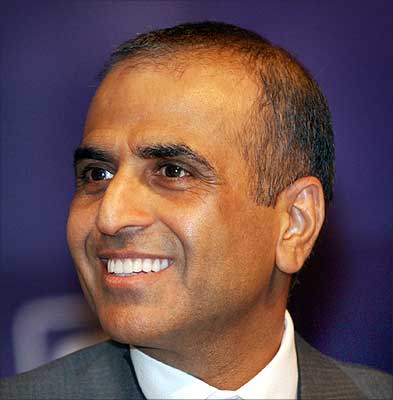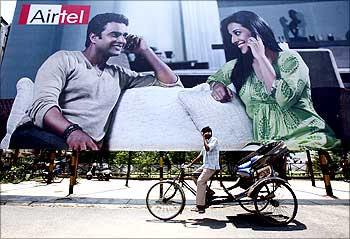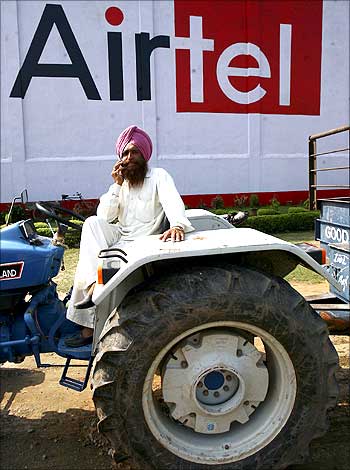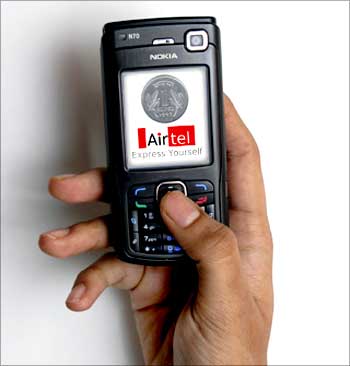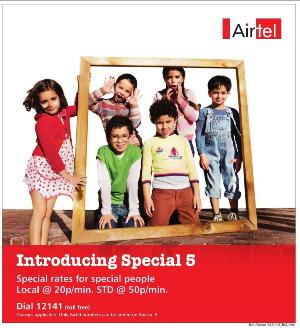 | « Back to article | Print this article |
What the Airtel game plan is
Let's look at your infotainment experience at home. You as well as every other adult have an Airtel mobile phone for long conversations, messages and e-mail.
Banks send out alerts on all transactions you do, airlines text any delay on your handset. For the old-fashioned, there is the Airtel fixed-line phone at one corner.
You never know when modern technology may fail and you have to go back to the old faithful.
Airtel broadband helps all in the family browse the net and Airtel direct-to-home fires the television. An Airtel home is the dream Sunil Mittal and his A-team at Bharti Airtel nurture.
The stepping stone is the 110 million subscribers of Airtel mobile telephony -- can they be made to buy Airtel fixed-line phones, broadband and DTH also?
Of the three, DTH is perhaps Bharti Airtel's most ambitious venture after mobile telephony.
The numbers at the moment are small -- just two million subscribers -- but the company feels it could do a mobile telephony here.
The situation does offer scope for exponential growth. Of the 240 million households in the country, 115 million have no television.
Of the 125 million television households, only 20 million have DTH -- others depend on cable or the government's terrestrial network.
DTH, the company is convinced, is like mobile telephony: Convenient, trendy and hassle-free.
There are signs that the market has taken off the springboard. DTH has been around for six years. In the first five years, 10 million households joined the bandwagon; in the last one year, the number has doubled.
But have prices fallen enough for the DTH market to explode? The installation cost for a customer works out to less than Rs 2,000 -- not very different from an entry-level mobile phone. Recharge options start at as low as Rs 125 a month. Click NEXT to read further. . .
What the Airtel game plan is
So, Bharti Airtel feels, there is no reason why no-TV, no-cable and cable-frustrated homes will not convert to DTH en masse.
"DTH will make people buy televisions," says Bharti Telemedia director & CEO Ajai Puri.
"The only rival is cable. But it offers limited channels and of these only the early channels have good picture quality."
(Bharti Telemedia is the DTH arm of Bharti Airtel. It has been made a strategic business unit for sharper focus.)
That DTH is the future of television cannot be contested. Sooner than later, consumers will switch to it for wider choice, convenience and better picture quality.
The problem is that the market place is already packed tight like a can of sardines.
Subhash Chandra's Dish TV has the early mover's advantage, and Tata Sky has on its side the enormous Tata brand equity, especially in the rural markets.
Price warrior Sun Direct is strong in the South.
Reliance BIG TV from the Anil Dhirubhai Ambani Group comes with enormous firepower.
Videocon d2h wants to make use of its strengths in hardware -- it has decided to bundle DTH with television and DVD players. Dish TV is endorsed by Shah Rukh Khan, Tata Sky by the infallible Amir Khan, Reliance BIG TV by Hrithik Roshan and Videocon d2h by Abhishek Bachchan.
Where does this leave Airtel?
Puri says Airtel hasn't done too badly. Though it has only 10 per cent of the DTH subscribers, it has bagged one-third of all new customers (one-fifth in the South) ever since it entered the market in April 2009. How?
What the Airtel game plan is
Tech advantage
Puri says the Airtel dish of 60-cm or 72-cm diameter is bigger than that of rivals. The company has installed the 72-cm dish in areas like Mumbai, Kerala and the North East where the signal can get distorted or even lost when it rains.
A bigger dish controls the damage. It has two data recovery sites, one at Manesar near Delhi and the other in Bangalore, so that if one shuts down due to bad weather, the rest of the country continues to get the feed without interruption.
Most important, says Puri, Airtel is the only DTH service provider, apart from Videocon d2h, to use the MPEG-4 DVB-S2 compression technology.
Its transponder on Indian Space Research Organisation's Insat 4CR satellite can manage environmental disturbances better than others and pump up the signal by as much as 17 per cent.
(Other transponders cannot boost the signal beyond 11 per cent.) All this, claims Puri, results in superior picture quality.
"All research shows consumers want better picture quality. We wanted to establish our superiority in the category with this," says he.
"We got the advantage of getting in last in the form of a better transponder." In fact, Airtel's recent Dil titli campaign with Saif Ali Khan and Kareena Kapoor played on the clarity theme.
"There was a huge impact on all brand scores across the country, including top-of-mind recall, intention to purchase and consideration to buy," adds Bharti Airtel senior vice-president (marketing) and head (brand and media) R Chandrasekar.
This has not cut much ice with rivals, though.
"MPEG-4 amounts to zero advantage to the consumer. There is no difference in the clarity, nor is there any other benefit. It is a technology for compressing more channels in a given bandwidth. This makes no difference to subscribers who are mainly concerned with the clarity of transmission and choice of channels," Dish TV chief operating officer Salil Kapoor says.
"For us, more transponders make up for the need to compress more channels in the given bandwidth because we have more bandwidth."
Rivals point out another catch here. MPEG-4 compression may help Airtel DTH save on transponder cost because it need not hire more than one. But the set-top box for it works out more expensive.
And this negates the transponder cost advantage. Indeed, Puri admits that his set-top boxes cost more than rivals'.
What the Airtel game plan is
"The subsidy (paid to the consumer by the service provider) on the set-top box is between Rs 2,500 and Rs 3,500 for the industry. Our figure would be closer to Rs 3,500 per box," says he.
Similarly, Airtel's universal remote control stick costs five times more than that of other service providers.
Again, the advantage it offers is limited, point out rivals.
"It combines the functions of the television and DTH control sticks. People use the television stick only to switch it on and off. So, a universal remote control stick is not much help," points out an industry expert.
Mobile network
Bharti Airtel has as many as 1.6 million outlets for its mobile telephony services. Consumers can buy connections and recharge their coupons here. It wants to use this network to sell DTH as well.
All these stores will be asked to stock the DTH hardware as well as provide recharge options.
"This is a clear strategic brand-builder and differentiator for us," says Puri. "It will be extremely difficult for others to match."
To be sure, distribution is a challenge most others are grappling with. Market leader Dish TV (share: 40 per cent) has about 50,000 sale outlets and 75,000 recharge points across the country.
But it realises the need to ramp up quickly. So, it is in talks with the Department of Posts to stock its recharge cards in post offices.
A pilot is expected to run in Punjab before it is scaled up to the rest of the country. Two, it is encouraging its dealers of recharge coupons to stock other brands too so that their business becomes more viable.
Airtel also plans to leverage its bank of 110 million mobile telephony subscribers to sell DTH.
According to Puri, 35 to 40 per cent of his DTH subscribers have experienced the Airtel brand through fixed-line or mobile telephony. Others too have caught on to the idea.
"We are in initial talks with some telecom players as well, who are not in the DTH space but have shown an interest, to bundle our services with theirs," says Kapoor of Dish TV.
Sceptics insist that the DTH market behaves like a combination of the telecom and consumer durables markets.
"So, a presence in the telecom sector will not arm a DTH player with learning that it will not have to tweak," says a rival who does not wish to be named.
"Airtel might have its telecom network to flaunt, but we have an extensive consumer electronics distribution chain through which we are retailing our d2h products. We already have a large dealer network at hand to sell from," adds Videocon d2h chief executive officer Anil Khera.
What the Airtel game plan is
Life after sale
DTH service providers have realised that they need to differentiate their content as well. "The need is to take the customers beyond just channels," says Puri.
Thus, Airtel DTH has tied up with NDTV to provide customised news round the clock. It also provides travel, astrology and film ticket services. Then there are games and movies on pay-per-view.
There is no way the usage of value-added services can be tracked, but Puri says that 3 to 5 per cent of customers have attempted games and pay-per-view movies which are easy to monitor.
The problem is that rivals are not far behind. Dish TV as well as Tata Sky offer a host of similar features, which leaves Airtel DTH with no real differentiator. "It is a category builder," admits Puri.
What Puri has done to break the clutter is detailed mapping of viewership habits in every state in the country. The premise here is that viewer needs are different in every state.
In Punjab, for instance, people do ask not for Hindi general entertainment channels like Star TV and Sony but channels that play Gurbani (verses from the Guru Granth Sahib). Movie channels are popular in Haryana, and IBN Lokmat is in huge demand all over Maharshtra.
"We have customised packages for various regions with regional channels," says Puri.
This means that Airtel DTH needs to have a large bouquet of channels in its portfolio.
"We have as many as 212 channels, which is next only to Dish TV," says Puri. After Dil titli, the width and quality of the content could be at the core of Airtel DTH's campaigns in the future.
What the Airtel game plan is
Puri also claims that market research agency IMRB has independently rated Airtel DTH on top in customer service.
The survey was carried out amongst existing and prospective customers as well as channel partners.
The parameters used were installation, call-centre and after-sale services. "Our benchmark was Tata Sky. We had to do better than it because we came to the market five years after it," says Puri.
Profits ahead?
The DTH industry is carrying on its books losses worth Rs 5,000 crore (Rs 50 billion), on account of the subsidy to the consumer on the set-top box. (With rising volumes, set-top box prices have come down 30 per cent in the last one year. Yet, the subsidy remains high.)
As Airtel has a 10 per cent share of the market, it is reasonable to assume that it carries 10 per cent of these losses as well, or around Rs 500 crore (Rs 5 billion).
Of all the industry players, only Dish TV has reported quarterly operating profits so far.
(It expects cash profits in the last quarter of 2009-10.)
What the Airtel game plan is
On the positive side, Puri claims, Airtel DTH manages to get more out of its consumers. Its average revenue per user is close to Rs 200, says he. The industry average is known to be between Rs 120 and Rs 130.
But the losses cannot be sustained for long. The DTH Operators' Association of India, the lobby group for the industry, has asked the government to reduce the tax on DTH.
This includes a licence fee of 10 per cent (of revenue), 5 per cent customs duty on all imports and entertainment tax levied by some states.
The Telecom Regulatory Authority of India, which also regulates DTH, has said that DTH service operators should pay for content 50 per cent of what is paid by cable operators.
"This is based on the assumption that there is under-declaration of subscribers by cable operators. But the under-declaration is significantly higher. We want TRAI to bring the cost for us down to 15 to 20 per cent of what cable operators pay," says Puri.
On his part, Puri is confident that these concessions will be granted to the DTH industry. But to be really profitable, he knows his job is to build scale.
"With eight to 10 million customers, the business will look very different," says he. The question is, how quickly can he get there?
